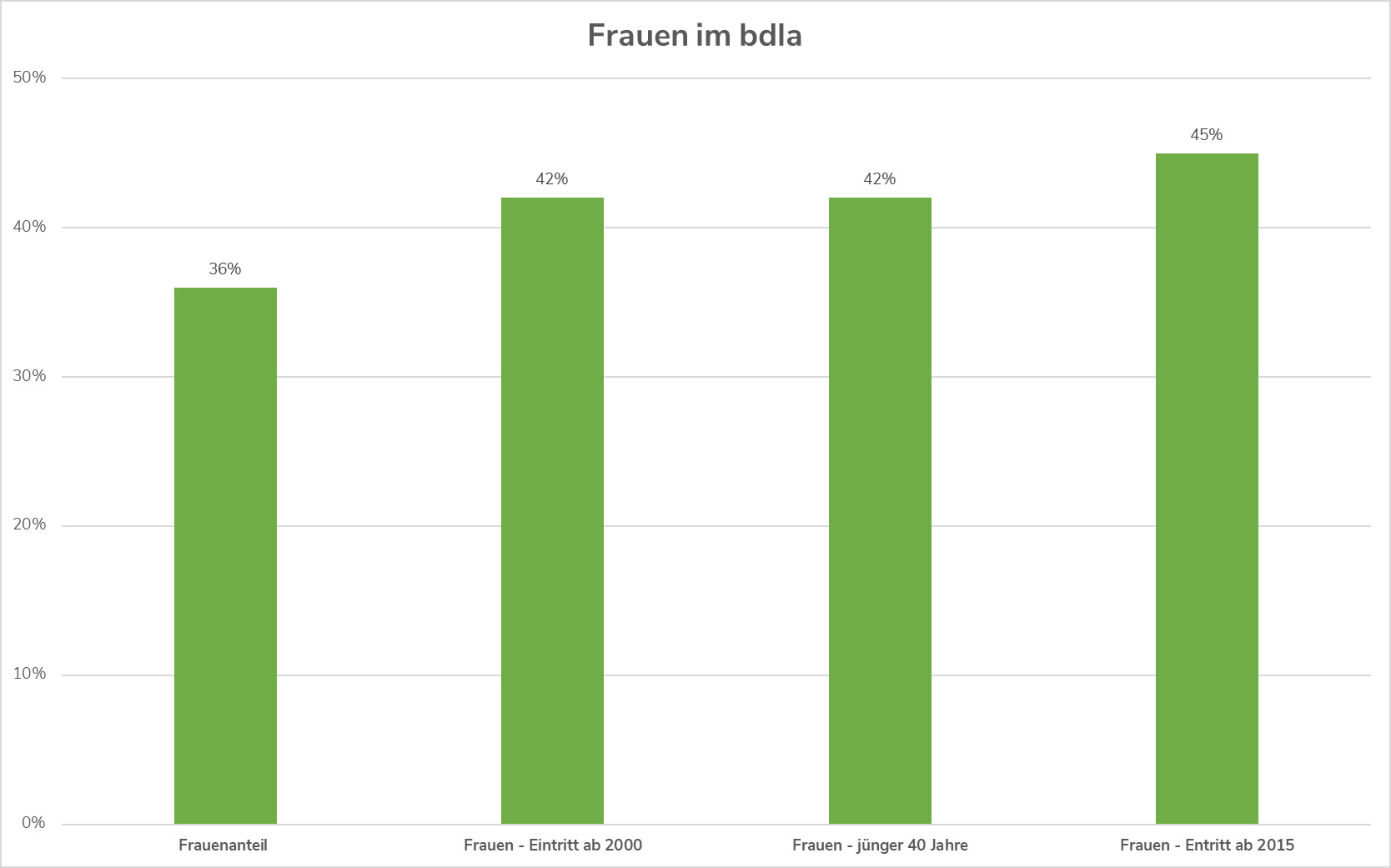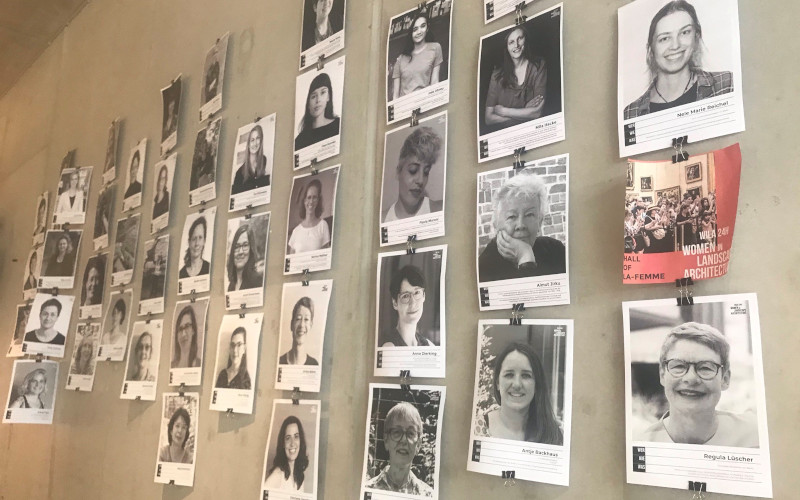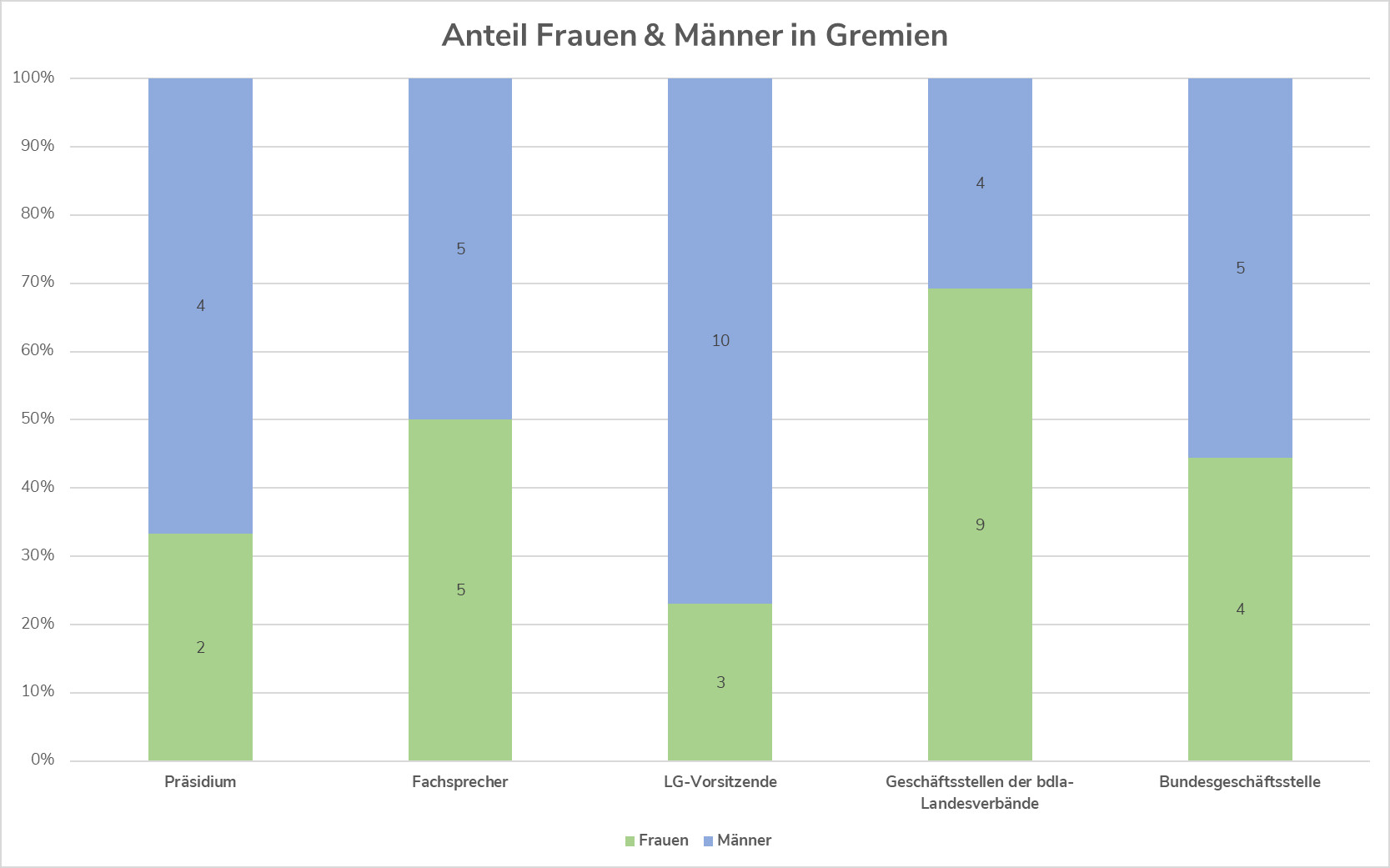By Petra Schoelkopf
In April of this year, the Advisory Board passed almost unanimously: As a first step towards more gender equity and diversity, an update of the association's name and logo will take place as a programmatic declaration of intent. We need to reflect again on what we stand for, who we want to reach, and how we communicate as an association in the future. It is therefore worth taking a brief look back.
Continuity with constant change
When the Bund Deutscher Gartenarchitekten BDGA (Association of German Garden Architects) was founded in 1913, surely no one was yet thinking of a generic masculine in the naming. Women were almost unrepresented in the profession. Ruth Pniower seems to have been the only one in the Bund, according to the chronicle of the bdla. Discussions on the formation of the name focused on the professionally meaningful delimitation of the professional title. A constant adjustment of the federation name to changed task fields and social basic conditions followed.
The association suffered the consequences of the Gleichschaltung at the time of the National Socialists and after the re-establishment in 1948, the name was changed in 1952 to "Bund Deutscher Garten- und Landschaftsarchitekten" and in 1972 to Bund Deutscher Landschafts-Architekten BDLA. After the fall of the Berlin Wall, the professional association of landscape architects in the BdA merged with the West German BDLA as early as 1989. Incidentally, these changes were always reflected in the most diverse logo variants and, for example, in the most recent adaptation in 2018, back to a pure word mark with sometimes more or less attention.
In the last century, a positive development towards more general equality and gender equality began in society, which among other things received a solid basis with Article 3 of the Basic Law in 1949. Educational institutions and the profession of landscape architecture became increasingly open to women. Meanwhile, 36 percent of female landscape architects are involved in the bdla (bdla membership statistics 2021) and the tendency has been increasing in the last decades among the upcoming generations, as a statistical evaluation of the development in the bdla (see Fig. 1) shows.

Landscape architecture is also in a good position in comparison to the other architectural professions in the chambers (the current statistics show about 45 percent female landscape architects but only a little over 36 percent women on average in all four professions in the architectural chambers of the federal states. Source: Federal Chamber of Architects).
Completely unclear and not statistically recorded is how many colleagues are organized who consider themselves diverse or should benefit from equal opportunities in a broader sense.
The Equality of Persons with Disabilities Act of 2002, the German Personal Status Act (PStG) of 2018 and the General Equality Act (AGG) of 2019 gave the equality debate new mandates for action.
It is all the more astonishing that, for example, the work of women is still not sufficiently perceived, that there is a struggle to overcome the gender pay gap, and that the design of our environment is very much from the male point of view, leading to discrimination in public spaces, including in landscape architecture.
Petra Schoelkopf
This circumstance inspired the bdla regional group Berlin-Brandenburg in 2021 in the context of the festival "Women in Architecture " to the refreshing initiative "WILA 24h - Women in Landscape Architecture".

Women architects also founded the association "Diversity in Architecture" in 2021, which aims first to make women visible in architecture and "later to focus on other injustices"(Dr. Ursula Schwitalla, Chair undamp; Founder and associate member of the BDA). The BDA was also the first association of freelancers to address this issue, and at the beginning of 2021 it changed its name to the Bund Deutscher Architektinnen und Architekten (Association of German Architects ).
What signal does the bdla set?
For the bdla, it is also time to overcome a limitation and rethink well-trodden paths. So this time it's about gender equity, diversity and inclusion and the commitment to these values internally and externally.
A look at the bdla's marketing strategy makes it clear that we as an association and as a profession have, and should have, a special responsibility in processes of social change, if only because of our professional understanding.
According to the assessment of Thomas Mudra and Uwe Vock, the concepts of the bdla must be adapted to the market again and again over time in order to keep pace with the development of the media and the attitude of society. Future orientation and progressiveness are anchored in the brand core as important guard rails and contribute significantly to being perceived as a social force and to building sympathy and trust (Thomas Mudra (2006): Marketing for the Profession of Landscape Architects - Developing a Brand).
The working group Gendergerechter bdla around Barbara Willecke and Anna Dierking from the WILA team, which was created by the presidium at the end of 2021, came to the consensus after intensive discussion that the bdla wants to go one step further for exactly this reason. This update is to be used to ensure that not only women, but all people feel explicitly addressed by the bdla.
The colon: a strong sign?
First, the bdla wanted to address the heart of its communication - the association's name and logo. With their modification, a signal can be set most effectively and at the same time point to the open process that has begun.
Since the founding of the association, the bdla has used the masculine for its professional title, which has taken over the function of the generic masculine over the decades. However, studies and experiments suggest that female or non-binary individuals, who could also be transgender or intersex, are inaccurately represented by the historically explicable but discriminatory technique of naming.
Experts agree that there is a causal relationship between language and thought. Language creates reality, is lived respect and determines our actions.
Petra Schoelkopf
The only thing they disagree on is how formative this connection is(see Compendium Gender Equitable Language, p. 12). However, effects up to influencing the choice of profession are conceivable.
Before implementation, however, there was the problem that the linguistic debate currently does not yet offer an authoritative and accepted solution.(ibid., p. 13-18) The recommendation of the AG Gendergerechter bdla was, after careful consideration, in favor of gendering with a special character, the colon. This makes the association name linguistically relatively discreet to Bund Deutscher Landschaftsarchitekt:innen and the logo gender-sensitive and at the same time aesthetically modified. This spelling includes all genders and is thus AGG-compliant and also inclusive, since the colon can be reproduced by speech output programs for people with visual impairments.
Of course, the colon - just like the other signs and linguistic options, e.g., the participial form (landscape architects) - does not have only advantages. So we will have to accompany and reflect this update and all further developments with the necessary openness.
The next steps: It remains exciting
The introduction of the adapted logo, for example, in the business equipment of federal and state associations can be done gradually and with care, especially with regard to the honorary and financial resources of the bdla. The formal amendment of the bdla statutes is being prepared and will be presented to the advisory board in 2023 for a decision, which will also include other changes required by association law.

The naming of committees and events and the introduction of gender-sensitive language in association publications are also on the agenda. This can be viewed critically against the backdrop of the current, sometimes strident linguistic and not insignificantly politically colored discussion. Or the bdla can approach the implementation with desire and creativity in formulating.
"Gender-sensitive language can change its shape depending on context and situation. It can appear elegant or awkward - depending on the people who use it. It is the individual product of the writers and speakers."(ibid., p. 42) And linguist Rudi Keller compares the process of language change to the emergence and discarding of trails, concluding that language states are not final states of processes but transitory episodes in a potentially infinite process of cultural evolution.
This is not enough, however. Concrete projects, also in practical professional practice and in the understanding of planning, will have to be defined and implemented by the association. For example, the representation of the sexes in association committees and the improvement of equal opportunities in professional practice must be optimized. Accompanied by the AG Gendergerechter bdla, a content-related discussion will have to take place in the association at all levels, in which everyone can participate in full diversity.
Author: Petra Schoelkopf, landscape architect bdla, freiraumforum. Landscape architecture open space marketing, Hanover, bdla-speaker public relations. The text appeared in the bdla association magazine "Landschaftsarchitekten" 2/2022.
- Latitude: 0
- Longitude: 0


